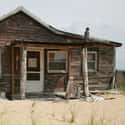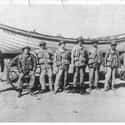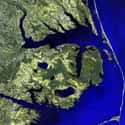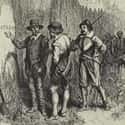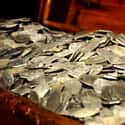-
(#4) "Bankers" Were Infamous For Scavenging Shipwrecks
"Bankers" is the term given to the people who lived along the edge of the Graveyard of the Atlantic for hundreds of years. These days, the strand is dotted with numerous, often luxurious vacation homes, hotels, and condos. But for the first 300 years of Outer Bank settlement, the region held no interest for the wealthy or the vacationing tourist. Property values were low, and the barrier islands could boast only of worn out, often broken down shacks. Not much could withstand the regular storms and fierce winds that roared up and down the coast. Most of the inhabitants lived there because they had nowhere else to go. Property values were low and poverty was common.
Except - sometimes this was not the case. There was one employment along the Banks that was often quite profitable, albeit at least somewhat illegal. It involved salvage. Bankers were notorious for watching boats and ships founder and wreck, then retrieving and claiming whatever washed up or what they could scrounge from the wreck. Now, salvage law is a little murky, then and even today. It is difficult to prove outright theft when items - however valuable - wash to shore or are abandoned in the shallows. Bankers regularly collected useful and valuable items for their homes, or to sell. Some items included furniture, expensive cloth, barrels of wine and spirits, luxurious clothing, artwork, and decorative objects.
Even if the Bankers took the items they found legally, they and their neighborhoods were looked down upon. Indeed, they were often referred to as "land pirates."
-
(#12) The Ghost Of A Murdered Surfman Is Said To Haunt The Coast
Nineteenth- and twentieth-century coastal surfmen were the unsung heroes and sometimes saviors at the Graveyard of the Atlantic. The young men lived much like firemen of today, in rescue stations, waiting for the call to rescue ships, boats, and people that were in the grip of the Graveyard. The Outer Banks had seven lifesaving stations at one time, scattered all along the 157-mile strand of islands.
The life of a surfman was a hard one, especially on the days and nights when a rescue was involved. Not a few of the young men perished while on duty. And, of course, not all the men hired to do the job were very good at it, or mature enough to take on such grave responsibility.
Such was the case with young T.L. Daniels, who was working as a surfman at Station Six in 1884. Today we would say that the young man had an "attitude," and struggled with taking orders from those of higher rank. In this case, the higher ranking individual was Captain James Hobbs, and he was a man who demanded obedience and did not suffer fools. Station Six was not known for being a place of discontent, but over time, the young surfman and his boss created an uncomfortable tension between themselves; and thus, the rest of the surfmen. They argued loud and long and frequently. On one occasion, Daniels began to insult Hobbs's wife and the latter decided he had had about enough from the surly young surfman. Hobbs pulled his revolver and shot Daniels dead right in front of the other young men.
Hobbs then directed the remaining surfmen to clean up the mess. It was decided that Daniel's body would be taken out in a boat and buried at sea. And so the Graveyard took yet another victim.
As for Hobbs? He walked. There were no police or other authorities nearby, so the entire crime was completely covered up, and Hobbs was cleared of any wrongdoing.
Those into visiting scenes of true crime might want to visit the Black Pelican Restaurant, which incorporated the old Station Six Lifesaving Station into its present location. Apparently, Daniel's ghost regularly haunts the site.
-
(#1) When It Comes To Nautical Terrors, Geography Is Everything
Just look at any map of North Carolina's Outer Banks. It can't help itself. A long, narrow strand of small islands stretches out into the Atlantic and curves around, hugging the North Carolina coast. Even the breakwater between the string of isles and the mainland area of the coast is replete with hidden coves and lagoons, perfect places for skulking pirates and other watery criminals.
The entire region has served as a wrecking magnet for watercraft, from the earliest years of European exploration right through WWII, and to this day, boaters and sailors cannot fully count on even the most modern RADAR and SONAR to protect them from the dangerous Graveyard of the Atlantic.
It's the storms - some coming from as far north as New England - that push vessels off course and sweep them down to the Outer Banks, where they are beaten by waves, or scuttled onto rocks, sometimes leaving survivors, but often times not.
-
(#10) The Lost Roanoke Colony Disappeared In The Graveyard
Lots of people have heard the legend of Roanoke Island's Lost Colony. But not everyone realizes that it was located right in the midst of what would become known as the Graveyard of the Atlantic. In fact, it is not unusual for visitors to the city of Roanoke, which is located in southwest Virginia, to assume they have arrived at the famous Lost Colony.
However, the Roanoke colony was actually located in the Outer Banks of North Carolina. In 1587, a group of 115 English colonists landed on Roanoke Island, just off the coast, and established a successful settlement. Their leader, John White, returned to England for supplies but he was delayed, and when he returned three years later, he found the entire colony had simply disappeared.
While no shipwrecks were reported during that brief period of English colonization, it remains a great mystery and tragedy in American history. Later arrivals, beginning with John Smith at Jamestown, were charged with inquiring as to the fate of the Roanoke colonists.
Theories have abounded over the 400 years that have passed since their disappearance. One of the more plausible ones has to do with the Roanoke colonists packing up and moving to what is now Hatteras Island, at the southern tip of the Outer Banks. It was true that their friend and tribal guide, Manteo, was from the southern Banks, though at that time his island was called "Croatoan" - which coincidentally was the word carved into the palisade of Roanoke Fort and discovered by John White when he got back to his vanished colony. Eighteenth-century visitors to Croatoan/Hatteras noted that they had met tribal people there who wore European clothing, had fair hair and gray eyes. They spoke of having ancestors who could "talk in a book" (read).
Today, the search for the Lost Colony continues, with ever more intriguing theories and suppositions. There is even an effort to locate the missing English families via DNA studies of people living in the Hatteras region today.
-
(#6) The Treasure Of El Salvador Is Still Lying Somewhere In The Graveyard
Yes, the legends and stories of Spanish gold lost in the Graveyard of the Atlantic are true. One of the most famous of these concerns a Spanish treasure fleet that was lost in the Outer Banks in 1770. It was called the El Salvador, and was among six ships loaded down with gold and silver from the New World.
One might wonder how and why did a fleet of Spanish ships wind up wrecked along the Outer Banks? Once again, the answer lies in geography -and the Gulf Stream. All six ships were sailing from Central America and up to the coast of Florida, where they headed out into the Atlantic. Unfortunately, they ran right into the northerly Gulf Stream, which pulled them off course, racing up the Eastern seaboard until North Carolina's infamous geography kicked in and dashed the ships onto rocks and into the shallows of the Graveyard of the Atlantic.
Some of the ships limped to shore and their cargoes were saved. Those that wrecked in shallow water were also somewhat spared, with surviving crew rescuing the precious cargo and hauling it to other waiting ships. But the El Salvador was never found. And to this day, treasure hunters are still looking for it. The cargo would be worth many millions of dollars today.
-
(#8) An Unlucky Gentleman Pirate Sailed His Ship "The Revenge" In The Graveyard
Blackbeard the pirate was only the most notorious among many people engaged in the scandalous trade amid the Graveyard of the Atlantic. Another pirate, nearly as famous as Blackbeard, was Stede Bonnet, better known as the "Gentleman Pirate." Hailing originally from Barbadoes, Bonnet came from a wealthy Caribbean planter's family. He was born to money, but apparently wanted money of his own and acquired it in the most adventurous way possible.
He built a ship called The Revenge, and one night he sailed north to the Carolinas, where he began his career of pillaging and looting. On one particularly memorable occasion, he ran into a Spanish warship, with whom he foolishly engaged and wound up losing half of his crew. He managed to escape with his ship and swiftly sailed to the Bahamas, where he had the bad fortune to run into Blackbeard, who took advantage of Bonnet's inexperience, and also his ship, eventually leaving Bonnet stranded in South Carolina.
Bonnet managed to reach Blackbeard's hometown of Bath, North Carolina, where he was somehow able to secure a pardon from the state governor, promising never to return to piracy. He lied, returning to his chosen profession at the first opportunity. However, he was captured in 1718, when piracy was no longer so fashionable in the Carolinas, and was tried, convicted, and hanged.
New Random Displays Display All By Ranking
About This Tool
In the North Atlantic Ocean, there is a mysterious sea area called "Graveyard Of Atlantic". This area is located near important routes between the United States and Canada. Over the past few hundred years, more than 500 large and small ships have mysteriously sunk near this area. The peculiar geographic location and ocean currents have caused various nautical disasters.
Many navigators are afraid of this sea area, and there are many weird and mysterious legends and tales about "Graveyard Of Atlantic", it seems to be controlled by the god of death. The random tool shares 12 interesting tales of Macabre who were from "Graveyard Of Atlantic".
Our data comes from Ranker, If you want to participate in the ranking of items displayed on this page, please click here.











